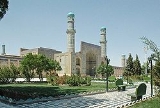
Friday Mosque of Herat
Encyclopedia
The Friday Mosque of Herat (مسجد جمعه هرات), also known as the Jumah Mosque, is a mosque
in the city of Herat
, in the Herat Province
of north-western Afghanistan
. It was built by the Timurids and extended by several rulers swapping hands down the centuries between the Timurids, Safavids, Mughals and the Uzbeks
all supported the mosque before switching hands. Though many of the glazed tiles have been replaced during subsequent periods, the Friday Mosque in Herat was given its present form during the closing years of the fifteenth century. Apart from numerous small neighborhood mosques for daily prayer, most communities in the Islamic world have a larger mosque for Friday services with a sermon. This was not always the largest mosque in Herat; a much larger complex also built by the Timurids, the Mosque and Madressa of Gawharshad, was located to the north. Those architectural monuments were dynamited by officers of the British Indian Army under British supervision in 1885 so that it could not be used as a fortress if a Russian army tried to invade India.
rulers redirected Herat's growth towards the North. This suburbanization and the building of a new Friday mosque in Gawhar Shad's Musalla marked the end of the Masjid-i Jami's patronage by a monarchy. Construction of a entire new building and surrounding gardens completed by Jalal al-Din Firuzshah, one of the most prominent amirs of Shah Rukh (1405-1444). It is said that the decorations alone were completed over the course of five years, bringing in workers from all over the empire. The mosque was given a final renovation under the Mughals of India, when prince Khurram (shah Jahan) was fighting for control of the region against the Uzbek tribes.
Mosque
A mosque is a place of worship for followers of Islam. The word is likely to have entered the English language through French , from Portuguese , from Spanish , and from Berber , ultimately originating in — . The Arabic word masjid literally means a place of prostration...
in the city of Herat
Herat
Herāt is the capital of Herat province in Afghanistan. It is the third largest city of Afghanistan, with a population of about 397,456 as of 2006. It is situated in the valley of the Hari River, which flows from the mountains of central Afghanistan to the Karakum Desert in Turkmenistan...
, in the Herat Province
Herat Province
Herat is one the 34 provinces of Afghanistan; together with Badghis, Farah, and Ghor provinces, it makes up the South-western region of the country...
of north-western Afghanistan
Afghanistan
Afghanistan , officially the Islamic Republic of Afghanistan, is a landlocked country located in the centre of Asia, forming South Asia, Central Asia and the Middle East. With a population of about 29 million, it has an area of , making it the 42nd most populous and 41st largest nation in the world...
. It was built by the Timurids and extended by several rulers swapping hands down the centuries between the Timurids, Safavids, Mughals and the Uzbeks
Uzbeks
The Uzbeks are a Turkic ethnic group in Central Asia. They comprise the majority population of Uzbekistan, and large populations can also be found in Afghanistan, Tajikstan, Kyrgyzstan, Turkmenistan, Kazakhstan, Russia, Pakistan, Mongolia and the Xinjiang Uyghur Autonomous Region of China...
all supported the mosque before switching hands. Though many of the glazed tiles have been replaced during subsequent periods, the Friday Mosque in Herat was given its present form during the closing years of the fifteenth century. Apart from numerous small neighborhood mosques for daily prayer, most communities in the Islamic world have a larger mosque for Friday services with a sermon. This was not always the largest mosque in Herat; a much larger complex also built by the Timurids, the Mosque and Madressa of Gawharshad, was located to the north. Those architectural monuments were dynamited by officers of the British Indian Army under British supervision in 1885 so that it could not be used as a fortress if a Russian army tried to invade India.
History
The Masjid-i Jami of Herat, the city's first congregational mosque, was built on the site of two smaller Zorastrian Fire temples that were destroyed by earthquake and fire. A mosque was begun by Ghurid ruler Ghiyath al-Din Muhammad b. Sam (1162-1202) in 1200 (597 AH), and continued after his death by his brother and successor Shihab al-Din. This is confirmed both by an inscription on the eastern Ghurid portal uncovered in 1964 during a restoration, and by the sixteenth century Timurid historian Khwandamir in his Khulasat al-Akhbar.Timurids
In the thirteenth century, Genghis Khan destroyed the province and the small building fell into ruin. Rebuilding and renovation programs were undertaken by the Mongol convert rulers. After a devastating earthquake in the mid 13th century the building left completely destroyed and left to collapse. After 1397, the TimuridTimurid
Timurid may refer to:* Timur , also known as Tamerlane in English, a fourteenth-century conqueror of Western, South and Central Asia, founder of the Timurid Empire and Timurid dynasty in Central Asia...
rulers redirected Herat's growth towards the North. This suburbanization and the building of a new Friday mosque in Gawhar Shad's Musalla marked the end of the Masjid-i Jami's patronage by a monarchy. Construction of a entire new building and surrounding gardens completed by Jalal al-Din Firuzshah, one of the most prominent amirs of Shah Rukh (1405-1444). It is said that the decorations alone were completed over the course of five years, bringing in workers from all over the empire. The mosque was given a final renovation under the Mughals of India, when prince Khurram (shah Jahan) was fighting for control of the region against the Uzbek tribes.

